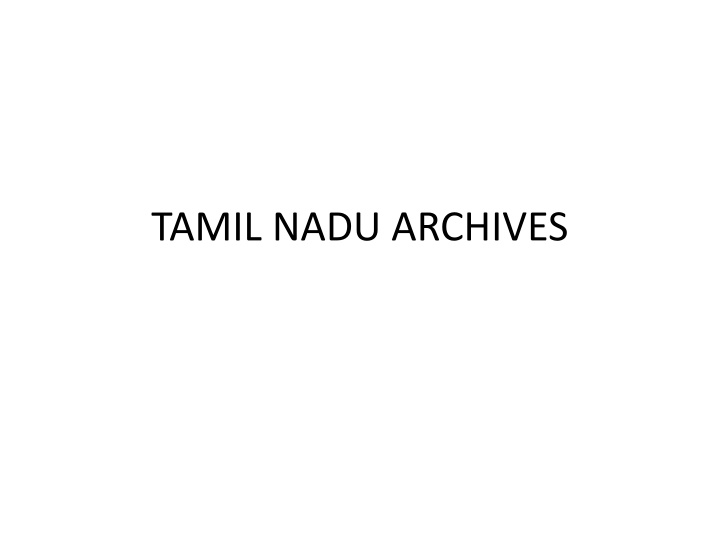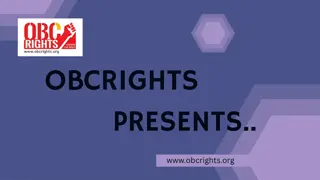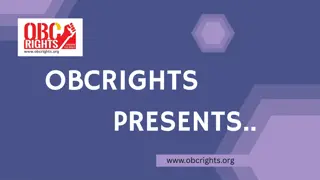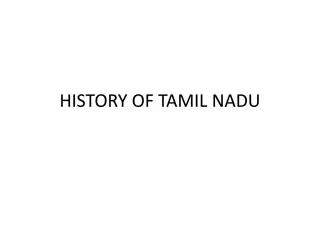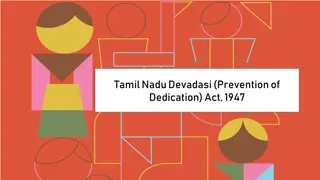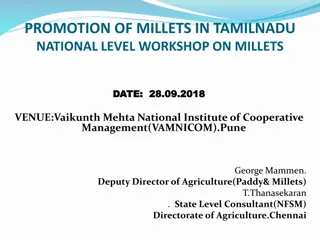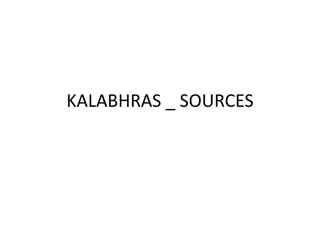History and Evolution of Tamil Nadu Archives
Tamil Nadu Archives, established in 1806, has evolved over the years from Madras record office to its current form. Initially kept in desks, the growth of records led to the need for a suitable building. Through recommendations and efforts of various individuals, it transformed into the present-day Tamil Nadu Archives, a repository of historical importance.
Download Presentation

Please find below an Image/Link to download the presentation.
The content on the website is provided AS IS for your information and personal use only. It may not be sold, licensed, or shared on other websites without obtaining consent from the author.If you encounter any issues during the download, it is possible that the publisher has removed the file from their server.
You are allowed to download the files provided on this website for personal or commercial use, subject to the condition that they are used lawfully. All files are the property of their respective owners.
The content on the website is provided AS IS for your information and personal use only. It may not be sold, licensed, or shared on other websites without obtaining consent from the author.
E N D
Presentation Transcript
Introduction Tamil Nadu Archives is mainly a Government archives . It was established in 1806 It was reorganised as a repository in 1909 with a separate building of its own . Until 1968 , it was called as Madras record office when it was chritened as Madras State Archives When Madras State was changed into Tamil Nadu , it was renamed as Tamil Nadu Archives .
Origin and growth of Tamil Nadu Archives In the middle of the 17th century , East India Company established its factories and offices in Madras . Correspondence was very few and therefore , documents were also few . As trade of the East India Company developed and it s political activity increased , More records came into being . In those days records were kept in Desks .
Under the guidance of the Governor of Madras , Mr. Stereynham Master ( 1678 1681) A system of Keeping Registers were first introduced . The volume of records increased year by year , thereby compelling the British Government to plan the expansion of suitable building and their internal arrangements to store the Public records in 1738 . The East India Company in Madras realized the importance and need for the centralization of provincial records. Lord William Bentink The credit of bringing all the records of the administration goes to Lord William Bentink . In 1805 he proposed that all the most recent records should be lodged together , under the charges of a special establishment , in the apartments numbered 18 to 21 on the north side of the Fort Square .
The Board of Directors responded to the recommendations , they allotted sum of 80 Pagoda per month . It was recommended that certain apartments on the north side of the fort aquare be for keeping the records . This organisation to be developed into Madras Record Office , now known by the name Tamil Nadu Archives . Talboys Wheeler : 1858 In 1823 , all the records were moved into the rooms of the first floor of the Government House in the Fort and again into the Pallor Godown in 1825 . In 1837 George Gaerrow was appointed for the purpose of arranging the records of Madras Presidency . William Hudleston was appointed in 1858 for the short period . Subsquently in 1860 , Talboys Wheeler was appointed .
Talboys Wheeler made thorough examination of records . He submitted his report on the records in 1861 and he established a new classification system not on the basis of subject but according to the nature and format of the records such as dispatches , consultations etc , As a result in the publications of two great books on Madras Presidency and British India namely Madras in the olden times in three volumes and Early records of British India . The record office was shifted to the ground floor of the secretariat building in 1888
New Building for Tamil Nadu Archives : 1909 The Government felt the necessity to have a separate spacious building to accommodate all the records . Sir Murray Hammic , the then Secretary to Government selected a Bungalow and its site known as Egmore near the southern railway station to be suitable for constructing a new building to house the records . In 1909 the cosulting architect was requested to prepare plans and estimates to construct a building to house the records . A building costing Rs. 2,20,323 and record racks costing Rs. 1,16,981 was ready for occupation by October 1909 , with a permanent Staff of One Superintendent , two Assistants , Five references , Three Clerks , two Typewriting Clerks and nine attenders .
Henry Dodwell : The First Curator 1911 1922 Henru Dodwell was an acting as Vice Principal , Teacher s College , Saidapet was appointed Curator , Madras Record Office from 15th April 1911 , for a period of two years . Dodwell s work The Government allotted some special work to the Curator in addition to his routine work . The Curator was properly arrange and Catalogue various papers and records of the government periodically . He had to examine the condition of the old records and send them for printing . At the same time , the government entrusted Dodwell with preparing the Calendars of the old records .
Accordingly Dodwell prepared with great effort and the first issue of the Calendar of Madras Records was published in 1917 , which covers the period of four years from 1740 1744 . He also prepared a Calendar of Madras Dispatches which covers the period from 1744 1755 , and the first issue was published in 1920 He is considered as the Guardian of the Records . In 1913 , he inaugurated the Mending system As per the orders of Madras government , he studied and analysed the nature and conditions of the records preserved in Tamil Nadu Archives and submitted his report in 1916 . In this report , he explained measures to be taken in future for the records .
He was highly interested in encouraging Historical Research . In South India , he was a first person who instigated the government to open Tamil Nadu Archives for Historical Research . He was an eminent Historian His literary contributions ranged wide and deep . His untiring work in Tamil Nadu Archives resulted in the Publication of some Valuable books in London . He opened a new chapter in the History of Tamil Nadu Archives . He left for London in 1922.
Sekhara Menon : 1925 Dodwell s departure to England In March , 1922 created a vacuum in the Tamil Nadu Archives . In 1923 , A. R. Cox , the Collector of Madras was entrusted to look after the Tamil Nadu Archives . On 27th April 1925 , Sekhara Menon joined as a Curator for one year . During his one year services a few volumes of records were taken over from the collections of Tanjore , Salem and Madras . He was the first Indian Curator who served in the office as a full time Gazetted officer
J .J. Cotton : 1926 1927 J. J. Cotton was the third Curator of Tamil Nadu Archives . In 1926 he was appointed for two years and had to revise the District Gazetteers and look after the administration of the office . A special establishment was allotted for the revision of Gazetteers Cotton took an active step to modernise the Tamil Nadu Archives by incorporating scientific instruments for the preservation and proper supply of information for Historical research . At first he decided to introduce a Photostat Machine for the Re- production of records . His efforts ended in failure . In 1980 a Xerox machine was installed in Tamil Nadu Archives .
A.V.Venkatarama Ayyar : 1927 1930 The unexpected death of J. J. Cooton in June 1927 created a vacuum in Tamil Nadu Archives . In 17th December 1927 , Venkatarama Ayyar was appointed as a full time officer . He implemented all the orders of government . For accommodating more records , an additional block was constructed which was ready in 1929 to accommodate a lot of volumes . Hence the pre mutiny records were placed in the newly erected seventh block .
Macqueen : 1930 1935 He was appointed as Curator of Tamil Nadu Archives on 12th April , 1930 . His service in Archives witnessed the accumulation of records in large scale . He took efforts to transfer the Collect orate records from 1836 to 1857 to Tamil Nadu Archives . One of the important contribution of Macqueen was the acquisition of Dutch records from Bombay and Calcutta to the Archives . During his period , 121 Volumes of Dutch records were transferred from Bombay and Calcutta and were Catalogued and indexed . He found a lot of valuable Church records at St. Mary s Church , Fort St. George and other Churches in Madras Presidency .
The Church Records consist of Birth , Marriages and Death Registers . The records covered the period before 1857 and contained important Historical matters . In order to save the records from fire , he took efforts for the installation of fire Extinguishers . He also prepared a Guide to the records preserved in Madras Record Office He encouraged the growth of historical research in Tamil Nadu Archives . Within five years he achieved a lot for the development of Record office . Dr . B. S. Baliga : 1934 1958 He encouraged Historical research . He acquired and preserved the records . His research works earned name and fame to the Tamil Nadu Archives . He was the first Indian trained in England for Archival administration .
He paid special attention to adding new records to the Record office . The District records from Salem , Malabar , North Arcot and Chittor were transferred to record office . The Survey records up to 1857 , and the records of Pudukkottai and Banganapalli states were acquired during his period . He started the Weeding work in October 1937 . During the Second World War , the records of the Madras Government preserved in the record office were transferred to Chittor district in 1942 All the original records of the Campany s period upto 1857 and the records of the Crown s period from 1857 were transferred to Chittor .
After the War was over , Baliga was able to transfer the records to Madras in 1950 . He well versed in records . He was an eminent writer . In 1936 he m prepared the Library Catalogue. He published Books , Catalogues , Gazetteers etc . Hu published the Book entitled Studies in Madras administration in 1942 . He published number of Journals. On 21st September , 1958 he died .
Later Developments After Baliga , S. Chidambaram was appointed as Curator . After that , C.P.Velu Evady IAS was appointed as Curator . On 6th June 1965 , S.Singarajan , an outstanding archivist , was appointed as Curator . During his period number of changes in the Record Management and Historical Research . One of his outstanding contributions of S. Singarajan , that he made archival awareness in South India by the Celebration of the Diamond Jubilee of Tamil Nadu Archives on October 1969. He introduced De- Acidification of records which gave a new life to the records . The Installation of Vacuum Fumication Chamber in 1972 was another great achievement of S. Singarajan .
In 1973 , the Tamil Nadu Government created the post of Commissioner of Tamil Nadu Archives and Historical Research and postedBadrinath as the first Commissioner . In 1974 , Badrinath prepared The report on the re- organisation of Tamil Nadu Archives which led to the development of Archives . In 1988 preparation of Guide to Records was started . In 1990 , four regional committees for the survey of Historical records were constituted for the collection and preservation of private records . In 1991, the Chief Minister M. Karunanithi appointed a Committee under Dr. S. Gopal to find out ways and means for the development of the Archives .
During the period of C.K.Gariyali ( 1995 1997 )Photo Archives was created by collecting a lot of Photos of personalities who participated in the Freedom Struggle and other Political and Social activities . For popularizing the Archives she conducted Photo Exhibition in Archives and other places in Tamil Nadu . She took the initiative of Air- Conditioning of Research Hall . Installation of Computers in Archives for computerising the records was another important measures in the Tamil Nadu Archives . During her tenure Tamil Nadu Archives was recognized by the University of Madras as Research Centre leading to Ph.D., degree . She introduced new method of lamination by using film as laminating material . This new method attracted all over India .
After Gariyali , Mr. Ragupathi became the Director of Archives on 6th November 1997 . During his period , Air Conditioned Research Hall was opened in June 1998 . The Districts Manuals of Tirunelveli , Salem , North Arcot and Tiruchirappalli have been reprinted . Some old rare books have been reprinted . After serving three and half centuries , the Tamil Nadu Archives has now entered into 21st century for serving the government and the public .
Structure and Function of Tamil Nadu Archives . It is a Big building . Twelve Block are utilized for stocks and one block for administrative purpose . The stock area is fitted with Steel Shelves. The entire building is provided fire Fighting arrangements and up to date modern equipment . It is comes under the administration of the Department of Education of government of Tamil Nadu . It is functioning under the control of a Commission of Archives and Historical Research , who shall be a senior I.A.S Officer . One Deputy Commissioner and Four Asst. Commissioner who look after all the functions of Archives .
Each record stock is placed under the charge of an Assistant ( Referencers ) A research assistant supervises the work of 2 or 3 Referncers . The Referencers is assisted by Record Clerks in collection and restoring papers and also in the preservation of Records . Archival Wealth Tamil Nadu Archives contains records of various languages . The earliest record here is dated 1036. The English records exist only from 1670 . All the records of the Secretariat from 1670 down to the present day with the exception of the records of the last four years .
All pre Mutiny records of the District Collectorate and the District Courts and Survey records up to 1857 are housed here Records of other heads of the Government and confidential records of various departments are kept in a separate record room . There are Nine Stacks where the Records , Maps and Books are kept . Stack I -- Medical , Public Administration , Public Health 1857 1974 Stack II __ Electrical rolls , Gazetters of India and 1962 to Present day Stack III __ Finance , Judicial , Law , Home , Social Welfare & Transport __ 1857 to 1972 Stack IV __ Revenue , Food , Commercial taxes , Agriculture , Forest , Fisheries , Industries , Labour , Housing , Rural Welfare 1857 1972 Stack V __ Library
Stack VI __ Military , Secret , Political , Petitions , Foreign etc . Public Department Records ( 1670 1856 ) , Secretariar Records up to 1856n, Dutch , Tanjore Ral , High Court , Church Records etc . Stack VII _ Marine , Irrigation , Public works etc Stack VIII__ Land Revenue , Board of rwevenue , cost of wars , settlement of estates . Records of Travancore ,Cochin Stack IX __ Origional survey Maps ,, Origional field measurement . Books etc . ______
